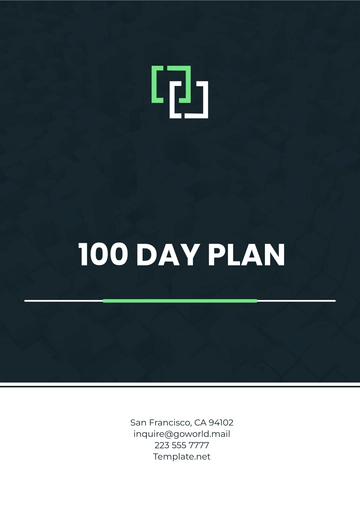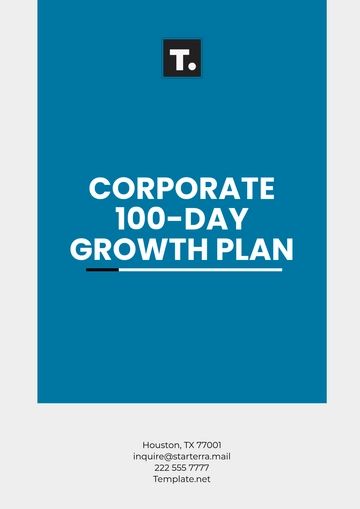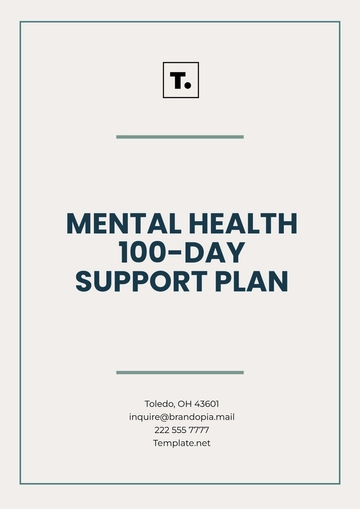Free Political Campaign 100-Day Strategy

Prepared by:
[Your Name]
[Your Company Name]
Introduction
A Political Campaign 100-day Strategy is an essential tool for outlining the early stages of a political campaign. It sets the groundwork for success by creating a roadmap that ensures the campaign hits key milestones, builds momentum, and establishes the candidate’s presence in the political landscape. The first 100 days of a campaign are crucial for voter outreach, fundraising, media engagement, and shaping public perception. This strategy is designed to guide the campaign team through these vital stages and maximize impact.
Day 1 to Day 30: Foundation and Awareness
Objective
Establish the Campaign Framework and Public Presence
Campaign Team Structure:
Hire key staff members, including a campaign manager, communication director, event coordinator, fundraising manager, and data analyst.
Organize internal operations, define roles, and set up communication channels.
Branding and Messaging:
Develop the campaign’s brand, including the logo, tagline, and visual identity.
Craft the core message that resonates with target demographics, focusing on the candidate’s key values, issues, and vision for the future.
Launch a campaign website and social media profiles.
Voter Outreach Strategy:
Identify key voter demographics and constituencies.
Implement a voter outreach plan, including email campaigns, targeted digital ads, and initial phone banking efforts.
Schedule listening tours and meet-and-greets to personally engage with voters.
Media and Communications:
Develop a press release announcing the candidate’s official entry into the race.
Begin outreach to local media outlets for interviews and articles.
Establish a social media content calendar, including regular posts and video updates from the candidate.
Day 31 to Day 60: Expansion and Engagement
Objective:
Increase Voter Engagement and Build Public Momentum
Fundraising:
Launch a fundraising campaign through online donations, events, and phone calls.
Set specific financial goals for the first 60 days, targeting both small donors and larger political action committees (PACs).
Host a virtual or in-person fundraising event featuring the candidate and key supporters.
Organizing Events:
Plan and execute local town hall meetings, community events, and debates.
Organize rallies and canvassing operations to engage with voters in targeted areas.
Partner with local organizations to co-host events that align with the candidate’s values and issues.
Expand Media Presence:
Begin running digital ads targeting key swing districts and demographics.
Pitch guest op-eds, interviews, and television appearances to increase visibility.
Launch a candidate blog to regularly share policy updates, personal stories, and responses to current events.
Polls and Feedback:
Conduct initial voter surveys and focus groups to gauge public opinion and identify areas of concern or interest.
Adjust campaign messaging based on feedback and polling results.
Day 61 to Day 90: Strengthening and Refining Campaign Strategy
Objective:
Consolidate Support and Expand Campaign Reach
Community and Voter Outreach:
Ramp up phone banking, door-to-door canvassing, and community outreach to strengthen relationships with constituents.
Establish volunteer teams in key regions to help with voter registration, canvassing, and event support.
Utilize targeted messaging through direct mail campaigns to inform voters about the candidate’s stances on key issues.
Enhanced Media Engagement:
Increase media appearances, including interviews on television and radio, as well as in podcasts and on social media platforms.
Strengthen relationships with political journalists and bloggers to secure regular coverage of the campaign.
Focus on key policy issues that resonate with the electorate, ensuring that the candidate’s message is clear and prominent in public discussions.
Fundraising Push:
Conduct a major fundraising push, aiming to exceed the 90-day goal set at the start of the campaign.
Host exclusive donor events with the candidate, offering a platform for deepening financial support.
Launch a donor recognition program to incentivize future contributions.
Refining Strategy:
Review voter feedback, poll results, and media coverage to refine the overall strategy.
Adjust campaign messaging and focus areas based on emerging issues or shifts in public opinion.
Prepare for a series of public debates, media appearances, or endorsements that could influence the race.
Day 91 to Day 100: Mobilization and Visibility
Objective:
Mobilize Volunteers and Solidify Candidate’s Public Profile
Volunteer and Supporter Mobilization:
Organize and train a strong volunteer base to support voter registration, canvassing, and get-out-the-vote efforts.
Develop and distribute campaign materials, including yard signs, bumper stickers, and flyers, to enhance visibility.
Launch a phone-banking blitz to connect with undecided voters and confirm support from supporters.
Media and Ad Campaigns:
Roll out targeted ad campaigns, both digital and traditional (television, radio), to increase visibility in key battleground areas.
Plan an ad buy strategy for the final stretch of the campaign, ensuring that advertisements align with the candidate’s key messages and target demographics.
Promote the candidate’s policy platform and leadership qualities through compelling storytelling in media appearances.
Debates and Public Engagements:
Prepare the candidate for debates and public forums with in-depth research and mock debates.
Attend high-profile community events to continue expanding visibility and showing a commitment to constituent concerns.
Engage with influential political figures and local leaders for endorsements.
Final Fundraising Effort:
Conduct a final fundraising push, maximizing contributions to secure the necessary resources for the final stretch of the campaign.
Launch a "last chance" donation campaign for supporters to show their backing.
Conclusion
The first 100 days of a political campaign set the foundation for future success. By focusing on building a strong team, establishing a clear message, and creating early visibility, a candidate can lay the groundwork for continued momentum. Through strategic outreach, media engagement, and fundraising, the campaign will establish itself as a serious contender in the race. As the campaign moves beyond the 100-day mark, it will be crucial to maintain and build upon the energy generated during this period to sustain support through the election.
- 100% Customizable, free editor
- Access 1 Million+ Templates, photo’s & graphics
- Download or share as a template
- Click and replace photos, graphics, text, backgrounds
- Resize, crop, AI write & more
- Access advanced editor
The Political Campaign 100-Day Strategy Template from Template.net is an editable and customizable tool designed to streamline your campaign efforts. Fully editable in our Ai Editor Tool, this template allows you to tailor strategies, set goals, and track progress, ensuring a well-structured approach to achieving success in the first 100 days of your campaign.
You may also like
- Finance Plan
- Construction Plan
- Sales Plan
- Development Plan
- Career Plan
- Budget Plan
- HR Plan
- Education Plan
- Transition Plan
- Work Plan
- Training Plan
- Communication Plan
- Operation Plan
- Health And Safety Plan
- Strategy Plan
- Professional Development Plan
- Advertising Plan
- Risk Management Plan
- Restaurant Plan
- School Plan
- Nursing Home Patient Care Plan
- Nursing Care Plan
- Plan Event
- Startup Plan
- Social Media Plan
- Staffing Plan
- Annual Plan
- Content Plan
- Payment Plan
- Implementation Plan
- Hotel Plan
- Workout Plan
- Accounting Plan
- Campaign Plan
- Essay Plan
- 30 60 90 Day Plan
- Research Plan
- Recruitment Plan
- 90 Day Plan
- Quarterly Plan
- Emergency Plan
- 5 Year Plan
- Gym Plan
- Personal Plan
- IT and Software Plan
- Treatment Plan
- Real Estate Plan
- Law Firm Plan
- Healthcare Plan
- Improvement Plan
- Media Plan
- 5 Year Business Plan
- Learning Plan
- Marketing Campaign Plan
- Travel Agency Plan
- Cleaning Services Plan
- Interior Design Plan
- Performance Plan
- PR Plan
- Birth Plan
- Life Plan
- SEO Plan
- Disaster Recovery Plan
- Continuity Plan
- Launch Plan
- Legal Plan
- Behavior Plan
- Performance Improvement Plan
- Salon Plan
- Security Plan
- Security Management Plan
- Employee Development Plan
- Quality Plan
- Service Improvement Plan
- Growth Plan
- Incident Response Plan
- Basketball Plan
- Emergency Action Plan
- Product Launch Plan
- Spa Plan
- Employee Training Plan
- Data Analysis Plan
- Employee Action Plan
- Territory Plan
- Audit Plan
- Classroom Plan
- Activity Plan
- Parenting Plan
- Care Plan
- Project Execution Plan
- Exercise Plan
- Internship Plan
- Software Development Plan
- Continuous Improvement Plan
- Leave Plan
- 90 Day Sales Plan
- Advertising Agency Plan
- Employee Transition Plan
- Smart Action Plan
- Workplace Safety Plan
- Behavior Change Plan
- Contingency Plan
- Continuity of Operations Plan
- Health Plan
- Quality Control Plan
- Self Plan
- Sports Development Plan
- Change Management Plan
- Ecommerce Plan
- Personal Financial Plan
- Process Improvement Plan
- 30-60-90 Day Sales Plan
- Crisis Management Plan
- Engagement Plan
- Execution Plan
- Pandemic Plan
- Quality Assurance Plan
- Service Continuity Plan
- Agile Project Plan
- Fundraising Plan
- Job Transition Plan
- Asset Maintenance Plan
- Maintenance Plan
- Software Test Plan
- Staff Training and Development Plan
- 3 Year Plan
- Brand Activation Plan
- Release Plan
- Resource Plan
- Risk Mitigation Plan
- Teacher Plan
- 30 60 90 Day Plan for New Manager
- Food Safety Plan
- Food Truck Plan
- Hiring Plan
- Quality Management Plan
- Wellness Plan
- Behavior Intervention Plan
- Bonus Plan
- Investment Plan
- Maternity Leave Plan
- Pandemic Response Plan
- Succession Planning
- Coaching Plan
- Configuration Management Plan
- Remote Work Plan
- Self Care Plan
- Teaching Plan
- 100-Day Plan
- HACCP Plan
- Student Plan
- Sustainability Plan
- 30 60 90 Day Plan for Interview
- Access Plan
- Site Specific Safety Plan





























